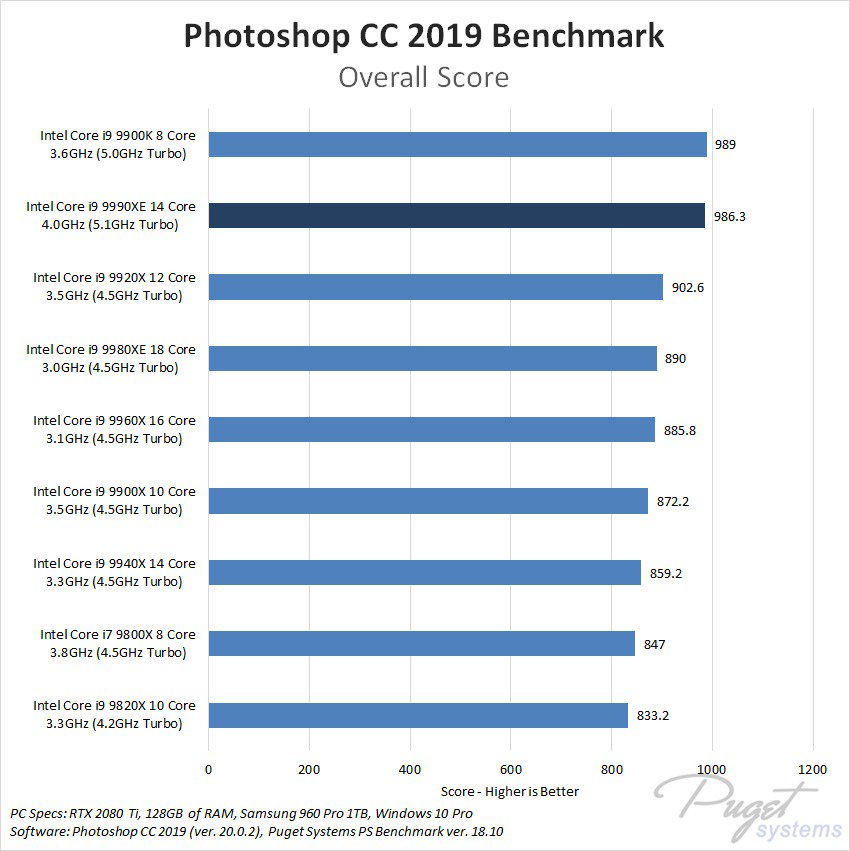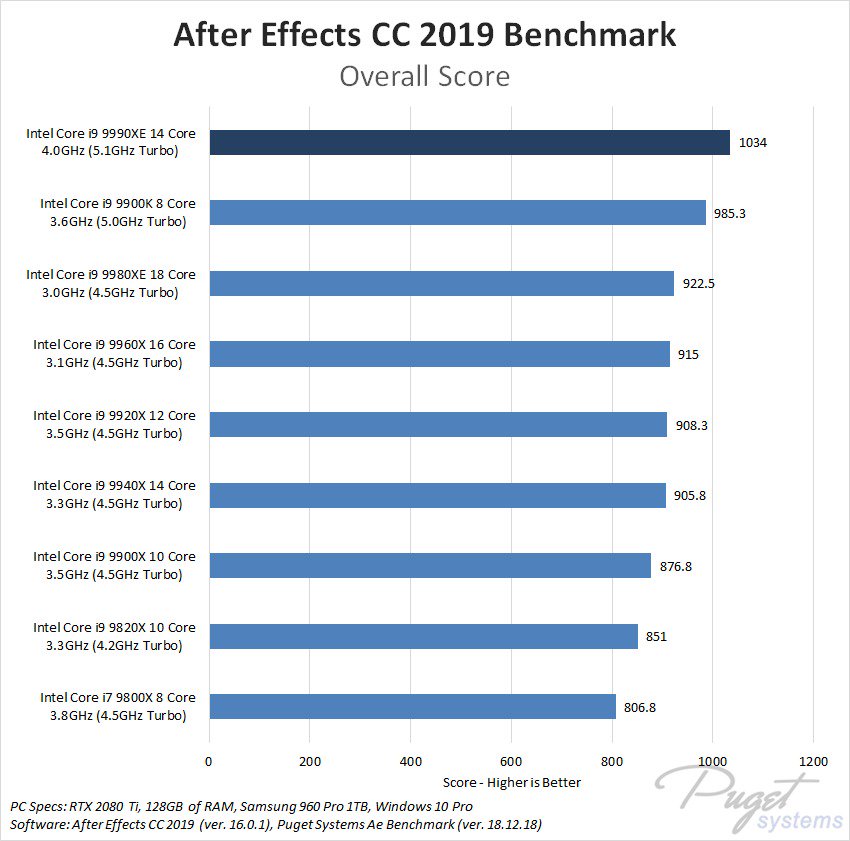Intel Core i9-9990XE Reviewed by Puget Systems
Intel's new Core i9-9990EX is certainly a rare breed of the company's highest performing silicon, but it doesn't even have a publicly listed product sheet. That's because Intel has only made the processor available to key OEMs in a secret online auction, with the prize chips going to the highest bidder. That means the only way to buy these processors is through a systems vendor.
Intel punches out millions of 'black ops' processors that never appear in official spec sheets or come to the retail market, but it primarily sells those on the enterprise side of its business. Intel designs these chips to customer specifications and they now total 50% of the company's Xeon sales to hyperscalers, but they will never see the light of day outside of mammoth data centers.
That business rakes in billions of dollars a year, so why not bring it to the consumer market? Well, Intel does that, too, but those custom models often land at OEMs for specific, and somewhat boring, devices.
The 14-core Core i9-9990XE is a different sort of beast, though, because it is headed to desktops. The chip was shrouded in mystery, revealed only by a bit of sleuthing by AnandTech, but now some of the processors have landed at Puget Systems.
Intel doesn't list an official price range for the Core i9-9990XE, but we're digging to learn more. So what kind of performance does a priceless processor provide? Puget Systems recently posted a few reviews of performance in Adobe applications to give us an idea.
Core i9-9990XE Specifications
The new chips feature 14 cores and 28 threads built on the Skylake microarchitecture, meaning these are high-performance variants of the Core i9-9940X. However, while the -9940X features a 3.3 GHz base clock and a 4.5 GHz boost, the -9990XE comes with a 4.0 GHz base, but more importantly, a 5.0 GHz all-core boost that stretches up to 5.1 GHz on two cores.
| Row 0 - Cell 0 | Cores /Threads | Base / Boost (GHz) | L3 Cache (MB) | PCIe 3.0 | DRAM | TDP | MSRP/RCP | Price Per Core |
| Core i9-9990XE | 14 / 28 | 4.0 / 5.1 | 19.25 | 44 | Quad DDR4-2666 | 255W | ? | ? |
| Core i9-9980XE | 18 / 36 | 3.0 / 4.5 | 24.75 | 44 | Quad DDR4-2666 | 165W | $1979 | $110 |
| Core i9-9940X | 14 / 28 | 3.3 / 4.5 | 19.25 | 44 | Quad DDR4-2666 | 165W | $1387 | $99 |
That type of performance certainly isn't possible with garden-variety Core i9-9940X chips, but these processors are built with the company's top-binned silicon. Like Intel's other Skylake chips, the processor supports DDR4-2666 on a quad-channel memory controller. However, the chips come without a warranty and have a 255W TDP rating.
Get Tom's Hardware's best news and in-depth reviews, straight to your inbox.
Given Intel's practice of measuring TDP at base frequencies, the chip will pull far more power when it engages its beastly all-core 5.0 GHz turbo boost. The chips are said to require motherboards that can deliver 420 amps to the socket, and that level of power consumption presents cooling challenges. To tame the thermal output, Puget Systems says its chips require a Corsair H80i cooler with two fans in a push/pull configuration.
Core i9-9990XE Test Results
Puget Systems put the Core i9-9990XE through its Adobe Photoshop CC 2019, Premiere Pro CC 2019, After Effects CC 2019, and Lightroom Classic CC 2019 test suites. We'll cover the overall scores from each of the tests, but Puget Systems has far more detailed results at the links above.
The company outfitted its Gigabyte X2999 Designare EX motherboard with eight 16GB DDR4-2666 memory sticks (128GB total) and an Nvidia GeForce RTX 2080 Ti 11GB to test the Skylake processor, and used a Gigabyte Aorus Z390 Pro WiFi board paired with four 16GB DDR4-266 modules (64GB total) with the same graphics card to test the Core i9-9900K.
Photoshop CC 2019 Benchmark.
As Puget Systems notes (and we've seen in our own testing), the Core i9-9900K provides a beastly level of single-threaded performance. Given the Adobe software's preference for single-threaded performance, that makes it a brutal contender, which we can see in the Photoshop test results. The Core i9-9900K's eight cores outpace its more extreme counterpart, but this comes as a byproduct of its similar dual-core 5.0 GHz boost. It's noteworthy that the other high core-count processors trail by a significant margin, meaning that the Core i9-9990XE is really the only way to get this class of performance in an HEDT processor.
After Effects CC 2019 Benchmark
The Core i9-9990XE is much more impressive in the After Effects tests. Several of the subtests leverage threading effectively, which plays into the hands of the -9990XE's 28 threads. The subtests also have several tests that profit from single-core performance and the -9990XE also led in those tests, too. As Puget Systems noted, the Core i9-9990XE is the best processor for After Effects, regardless of the use-case.
Premiere Pro CC 2019 Benchmark
The -9990XE took the top of the charts in the Premiere Pro testing, but the gains are slight over more conventional HEDT processors. Puget Systems notes the likely exorbitant price tag, lack of a warranty, and high power draw makes this processor hard to justify for this type of workload.
Lightroom CC 2019 Benchmark
The Core i9-9990XE took a healthy lead in the overall Lightroom Classic score, Much of that advantage came on the back of its high score in the preview and panoramic creation subtests, while the remainder of the subtests weren't as impressive.
Thoughts
Overall the Core i9-9990XE doesn't appear to be the best bang for your Adobe buck in some applications, as many of the gains are slim enough not to warrant the extra investment. The Core i9-9900K is impressive throughout the Adobe suite, but if you also tend to run heavily-threaded workloads, like rendering, the -9990XE's fourteen cores paired with the 5.0 GHz all-core boost would be an attractive proposition. We also expect that systems built around these processors will be popular with financial traders, where milliseconds equate to dollars.
Puget Systems says that it will post more benchmarks in other programs in the future, so we might learn more soon about the -9990XE's performance in other types of workloads. In the meantime, we're digging to learn more about how much the chips cost at auction and how much systems built around them will cost.

Paul Alcorn is the Editor-in-Chief for Tom's Hardware US. He also writes news and reviews on CPUs, storage, and enterprise hardware.
-
mischon123 12 chips that do exactly the same within a 20% envelope which, in real world applications, just about levels them. Perceived segmentation. Panic on the titanic?Reply -
tricecold Milliseconds and financial trading??? Is there such a buy and sell a trader does on it's local machine at the moment of buy and sell anyway? Mostly limit orders get uploaded and then executed when conditions are met and even then you are binded by network speed etc.Reply
Then why Adobe test and why only against Intel. What good is an hardware article to it's readers if it is not able to make a proper comparison -
Paul Alcorn Reply21758381 said:Milliseconds and financial trading??? Is there such a buy and sell a trader does on it's local machine at the moment of buy and sell anyway? Mostly limit orders get uploaded and then executed when conditions are met and even then you are binded by network speed etc.
Then why Adobe test and why only against Intel. What good is an hardware article to it's readers if it is not able to make a proper comparison
Yup, network latency is an issue for HFT, so many of them have super-fast connections and lease space as close to the Wall Street servers as they possible can.
We're discussing Adobe tests because, frankly, they are the only ones available (we didn't conduct the testing). Intel isn't going to sample these chips to reviewers.
Also, this system vendor is likely bringing systems to market with these chips (more on that to come), so it's relevant.
-
dbdarrough The article says, "Given Intel's practice of measuring TDP at base frequencies, the chip will pull far more power when it engages its beastly all-core 5.0 GHz turbo boost. The chips are said to require motherboards that can deliver 420 amps to the socket, and that level of power consumption presents cooling challenges." Yeah, I would think so. I believe you probably meant Watts not Amps!:)Reply -
rantoc So another binned/factory overclocked chip sold at high premium. Intel who can't produce enough chips really goes through all options to gain some money, like going through the trash bins for cpu's with defective gpu's and even have the stomach sell that "trash" for the full price.Reply -
Olle P Just what you want for crypto mining... ;)Reply
... with the most expensive places being within a few feet of the server.21758607 said:Yup, network latency is an issue for HFT, so many of them have super-fast connections and lease space as close to the Wall Street servers as they possible can.
Given the low voltage they're about the same number, and amps does seem correct if you compare to the 9900K:21758783 said:... I believe you probably meant Watts not Amps! :)
TDP 95W, peak power ~200W.
-
cryoburner Reply
If the only benchmark results come from the people who are trying to sell you the product, I'm not sure that can be considered a "review".21758607 said:Also, this system vendor is likely bringing systems to market with these chips (more on that to come), so it's relevant.
To tame the thermal output, Puget Systems says its chips require a Corsair H80i cooler with two fans in a push/pull configuration.
A 120mm AIO cooler for a 255 watt TDP processor boosting 14 cores to 5.0 GHz? Something tells me the processor would throttle like mad under such a setup, and would likely be stuck at its 4.0 base clock with all cores are active for more than a few seconds. -
Olle P Reply
Oh yee of little faith...cryoburner said:A 120mm AIO cooler for a 255 watt TDP processor... Something tells me the processor would throttle like mad...
Asetek some 15 years ago marketed (one of) their first 12cm radiators as beeing suitable for up to 400W.
What bugs me in the Review is that they didn't use the same, or even similar, cooler for the two CPUs, since they have essentially the same TDP.




